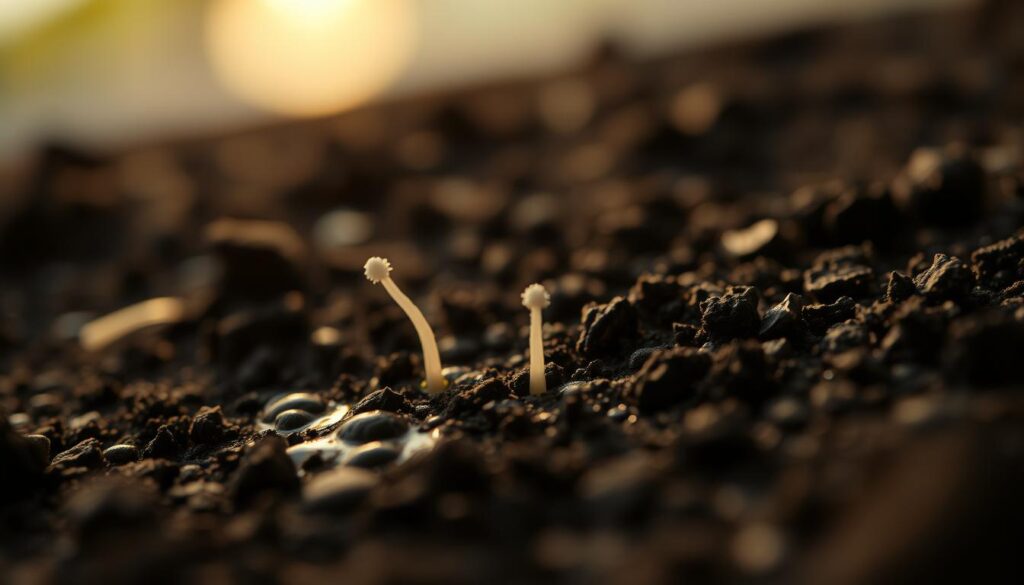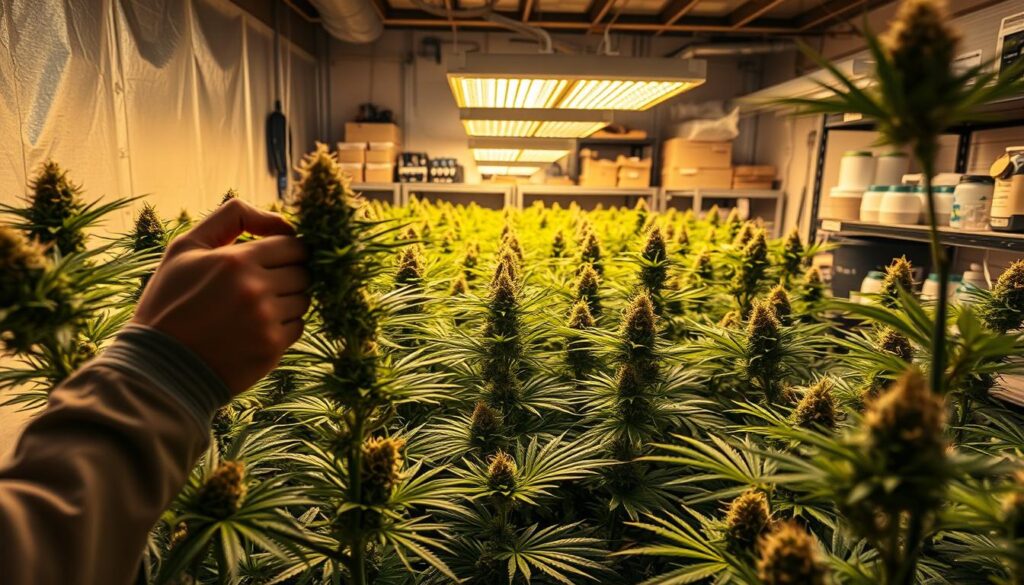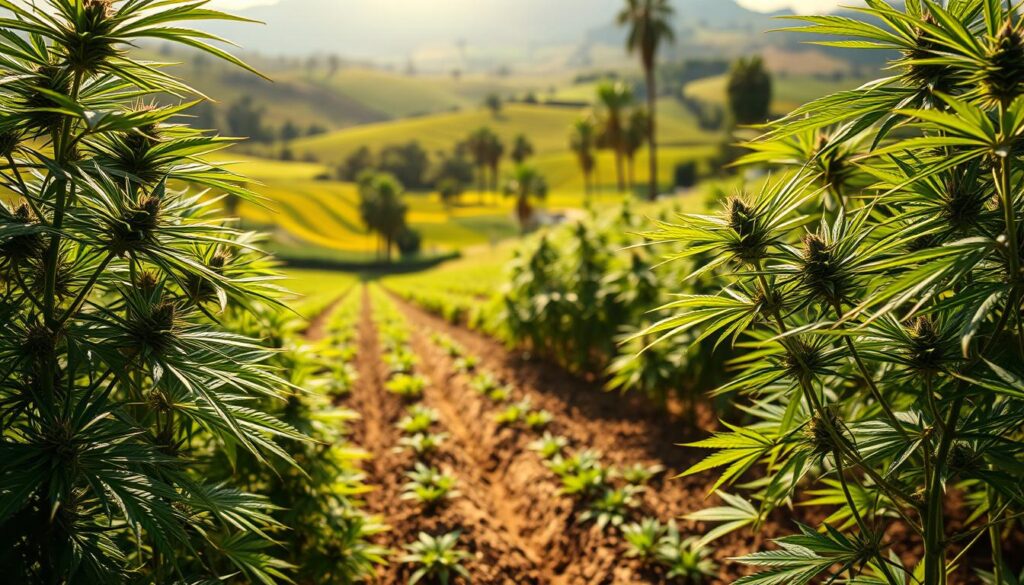Growing weed in San Salvador is tricky. El Salvador has strict laws against it. This guide is for those who want to learn about plants in tough places. But remember, growing weed here is very risky and we don’t suggest breaking the law.
First, learn about San Salvador’s weather and soil. Indoor grows with special lights might be better than outdoor ones. This is because of the area’s heavy rain. Also, good air flow is key when it gets too humid.
Knowing local terms like “hierba” can help you find secret gardening groups. But never talk openly about growing weed. We focus on quiet ways to grow, like small hydroponic systems. We’ll also share tips on finding seeds that are safe and effective.
Key Takeaways
- El Salvador’s complete cannabis ban makes cultivation legally risky
- Indoor climate control outperforms outdoor growing in tropical conditions
- Local gardening communities use coded language for discretion
- Compact hydroponic systems reduce visibility
- Seed selection impacts both yield and security
- Proper ventilation prevents mold in humid environments
Understanding the Cannabis Culture in San Salvador
San Salvador has a complex history with cannabis. For years, strict laws and changing views have shaped this relationship. Neighboring countries are exploring new paths, but El Salvador sticks to a zero-tolerance approach. It’s important to know the risks before getting involved with cannabis here.
The History of Cannabis in El Salvador
Cannabis came to El Salvador in the early 1900s. But soon, strict rules were put in place. Unlike Mexico or Costa Rica, where it was used traditionally, El Salvador banned it by the 1970s.
The civil war made things worse. Cannabis was seen as part of the problem. Today, the laws are the same, even as other countries talk about changing theirs.
For example, Costa Rica talked about legalizing medical cannabis in 2022. But El Salvador hasn’t followed suit. You can read more about Cannabis in El Salvador online.
Current Legal Status of Weed
In San Salvador, both medical marijuana San Salvador and recreational marijuana San Salvador are illegal. Having any cannabis can lead to fines, rehab, or jail. There’s no room for medical use here, unlike in some U.S. states or Canada.
Police focus on drug crimes, and the penalties are harsh. Growing cannabis is risky, so most is smuggled in. Here’s how policies compare in the region:
| Country | Medical Use | Recreational Use | Penalties |
|---|---|---|---|
| El Salvador | Illegal | Illegal | Fines + Jail |
| Costa Rica | Decriminalized | Illegal | Fines Only |
| Guatemala | Pending Bills | Illegal | Community Service |
Social Perceptions and Attitudes
In San Salvador, many see cannabis as bad. They link it to crime or addiction. Young people might be curious, but talking about it openly is rare.
There are a few key points to remember:
- Church groups often oppose legalizing cannabis
- News often talks about cannabis and crime
- There’s little education on the safe use of cannabis
If you’re visiting San Salvador, be careful what you say about cannabis. While opinions might change, it’s best to be cautious for now.
Planning Your Grow Space
Before you plant your first seed, designing a functional and discreet grow space is key. You might have a spare room or a hidden backyard. Good planning means healthier plants and less legal trouble. Let’s look at your options and must-have tools.
Outdoor vs. Indoor Growing
Indoor setups give you control and stealth, which is important in San Salvador. You can use compact tents and devices like the Arizer XQ2 to hide smells. Outdoor gardens might be cheaper but are riskier due to weather and visibility.
Here’s a quick comparison:
| Indoor | Outdoor | |
|---|---|---|
| Privacy | High | Low |
| Cost | $$$ | $ |
| Risk Level | Controlled | Exposed |
Setting Up Proper Lighting
Lighting is vital for your plants. LED grow lights are good because they save energy and don’t get too hot. For the flowering stage, use full-spectrum bulbs that mimic sunlight. Keep lights 18–24 inches away to avoid burning your plants. Use timers for a consistent 18/6 light cycle during the growing phase.
Essential Equipment for Your Grow
Here are the basics:
- Ventilation system: Carbon filters cut down on smells; inline fans help with airflow.
- pH meter: Check soil or hydroponic solutions every week.
- Hydroponic trays: Great for root support in small spaces.
Don’t rely on marijuana delivery San Salvador services. They’re not reliable and could get you into trouble. Instead, buy quality equipment for a successful harvest.
Choosing the Right Strain
Finding the right cannabis strain is like finding a secret garden. It affects how easy it grows and its effects. In San Salvador, where the weather changes a lot, picking strong strains is key. We’ll show you how to pick the best one for your needs.
Indica vs. Sativa: What to Know
Indica and sativa are more than just names. They tell you how your plant will act. Indica strains are short and bushy, great for hiding plants outside. They like cooler nights and make you feel relaxed.
Sativa varieties grow tall and need lots of sun. They give you a boost of energy, perfect for daytime.
| Type | Height | Growth Time | Best For |
|---|---|---|---|
| Indica | 3-4 ft | 8-9 weeks | Small spaces, relaxation |
| Sativa | 6-8 ft | 10-12 weeks | Sunny areas, creativity |
Popular Strains for Beginners
New to growing? Try these easy strains:
- Northern Lights: Low odor, pest-resistant, and loves warm climates
- Blue Dream: Balances euphoria and pain relief
- AK-47: High yield with minimal maintenance
These strains are popular in San Salvador. They can handle sudden weather changes.
Factors Influencing Strain Selection
Before picking seeds, ask yourself these questions:
- Climate adaptability: Can it survive 80°F days and tropical storms?
- Stealth needs: Does it have a mild scent to avoid detection?
- Purpose: Want CBD for pain or THC for recreation?
Local growers mix hybrid strains for the best results. For example, Girl Scout Cookies has strong yields and a mild smell. It’s a good choice for city gardens.
Germination and Seedling Care
Starting your cannabis journey is exciting. It begins with germination and seedling care. These steps are key to growing healthy plants. But, they can also cause problems if not done right.
Before you start, remember buying seeds online can be risky. It’s better to buy from trusted local places or seed banks. This way, you avoid legal trouble.
Best Germination Techniques
The paper towel method is great for beginners. Put seeds in damp paper towels. Keep them warm and dark, checking daily for roots.
When roots are ¼ inch long, move them to soil. If you’re using soil, soak it first. Use pH-balanced water (5.5–6.5) to avoid shock.
| Method | Success Rate | Time to Sprout | Ease of Use |
|---|---|---|---|
| Paper Towel | 90% | 2–5 days | Easy |
| Direct Soil | 75% | 4–7 days | Moderate |
| Water Soak | 80% | 3–6 days | Easy |

Ensuring Successful Seedling Growth
Seedlings need gentle care. Use a humidity dome for 70% humidity and 68–77°F temperatures. Don’t overwater—let the soil dry a bit before watering again.
Start with a diluted nutrient solution (¼ strength) when true leaves appear. Use nitrogen-rich formulas to help them grow.
- 18–24 hours of light daily (LED or fluorescent)
- Keep airflow soft to prevent stem damage
- Check pH levels every 2–3 days
Common Mistakes to Avoid
Don’t overwater your seedlings. Wet soil can kill them by cutting off oxygen. Also, too much light or heat can burn their leaves.
Always check the pH of your water. Ignoring it can stop your plants from getting nutrients.
Pro tip: Never buy seeds from unverified “buy weed online San Salvador” ads. Stick to reputable breeders to avoid legal issues and low-quality genetics.
Optimal Growing Conditions
To grow great cannabis in San Salvador, you need to balance climate, growing medium, and nutrition. Getting these elements right means bigger yields, better flavors, and fewer headaches. Let’s break down how to create conditions your plants will love.
Ideal Temperature and Humidity Levels
Your plants crave consistency. Keep daytime temperatures between 70-85°F and nighttime temps above 60°F. Humidity should start at 60-70% during vegetation, then drop to 40-50% as buds form. Pro tip: Use a digital hygrometer—it’s like a weather station for your grow space.
Soil vs. Hydroponics: Pros and Cons
Soil growers get easier startup and natural buffers against mistakes. But finding quality cannabis products San Salvador can be tricky—commercial soils often lack proper drainage here. Many locals mix their own using:
- 30% coconut coir
- 40% composted bark
- 30% perlite
Hydroponic systems shine in odor control and faster growth. They’re perfect for urban growers wanting discretion. Check out this comparison:
| Factor | Soil | Hydro |
|---|---|---|
| Startup Cost | $50-$100 | $200+ |
| Growth Speed | Standard | 25% Faster |
| Odor Control | Moderate | High |
Nutrient Requirements for Healthy Plants
Cannabis needs three main nutrients: nitrogen (N), phosphorus (P), and potassium (K). During vegetation, aim for a 3-1-2 NPK ratio. Switch to 1-3-2 when flowering starts. Success Nutrients’ Grow & Bloom formulas make this easy—their synthetic blends let you adjust doses like a pro.
Don’t forget micronutrients! Calcium and magnesium shortages often show as yellow leaves. If using local cannabis products San Salvador, test pH weekly. Hydroponic systems need 5.5-6.0 pH, while soil prefers 6.0-6.8.
“Precision beats guesswork every time. Measure twice, feed once.”
Maintaining Your Plants
Keeping your cannabis plants healthy needs daily care. Whether indoors or outdoors, small changes in watering, pruning, and pest control help a lot. Here are the basics to keep your garden healthy, even without daily trips to a weed shop San Salvador.

Watering Guidelines
Watering might seem easy, but too much is a mistake. Check soil moisture by sticking your finger 1–2 inches deep. If it’s dry, water your plants.
Use room-temperature water to avoid shocking the roots. Make sure pots have holes at the bottom to prevent root rot. Outdoor growers should water early in the morning to reduce evaporation. Adjust your schedule during rainy seasons to avoid waterlogged soil.
Pruning and Training Techniques
Low-stress training (LST) helps increase yields without stressing plants. Gently bend stems and secure them with soft ties to expose more buds to light. This is great for tight spaces or small grow tents.
Trim yellowing leaves weekly to help healthy growth. Use clean scissors to avoid spreading diseases. For bushy plants, remove lower branches to improve airflow and light penetration.
Dealing with Pests and Diseases
Homemade solutions save money and work well. Mix neem oil with water and spray leaves weekly to deter aphids and spider mites. For fungal issues, a baking soda solution (1 tbsp per gallon of water) can stop mildew spread.
If pests don’t go away, try companion planting. Marigolds or basil repel insects naturally. Always isolate infected plants to protect the rest of your garden.
| Homemade Pesticide | Ingredients | Best For |
|---|---|---|
| Neem Oil Spray | Neem oil, water, dish soap | Aphids, mites, mildew |
| Garlic Pepper Mix | Garlic, cayenne, water | Beetles, caterpillars |
| Baking Soda Solution | Baking soda, water, oil | Powdery mildew |
Harvesting Your Weed
The moment you’ve been waiting for has arrived – it’s time to reap the rewards of your hard work. Harvesting cannabis is both an art and a science. It requires careful timing and technique to preserve your plant’s potency and flavor. Let’s break down how to maximize your yield while staying discreet.
When to Know It’s Time to Harvest
Your plants will visually signal their readiness. Check trichomes (those tiny crystal-like hairs) using a jeweler’s loupe. Clear trichomes mean “wait,” while milky-white ones with 10-20% amber indicate peak THC levels. Start flushing plants with plain water 1-2 weeks before harvest to remove excess nutrients.
Proper Harvesting Techniques
Use sterilized pruning shears to cut branches at the base. Trim large fan leaves first – these contain fewer cannabinoids. Handle buds gently to avoid knocking off trichomes. Work in a well-ventilated area, and consider harvesting at night when terpene levels are highest for better aroma.
Curing Your Buds for Optimal Flavor
After drying buds for 7-10 days in a dark room (55-65% humidity), transfer them to airtight glass jars. Open jars daily for 15 minutes during the first week – this “burping” releases moisture and prevents mold. Proper curing takes 2-4 weeks but transforms harsh smoke into smooth, flavorful hits.
“Slow curing unlocks flavors you didn’t know your strain had. Patience pays off in every puff.”
Store cured buds in a cool, dark place using humidity packs to maintain 58-62% moisture. Avoid plastic bags – they can create static that damages trichomes.
Legal and Ethical Considerations
Growing cannabis in San Salvador needs careful thought. You must know the laws and act responsibly. This way, your grow stays safe and good for the community.
Know El Salvador’s Strict Laws
California’s rules don’t apply here. El Salvador has tough penalties for growing without permission. Even for personal use, it can lead to fines or jail. Always follow the law to stay safe.
Grow Small, Stay Discreet
Small grows are less likely to get noticed. Don’t talk about your plants online. Use ways to hide smells and keep your area safe.
Being ethical means caring for your neighbors and the planet. It’s important to grow without harming the environment.
Educate Yourself Safely
Want to learn about growing cannabis? Use VPNs to keep your online activities private. Sites like NORML and High Times have good info. But, always check local laws for updates.
Being careful and informed helps make cannabis culture safer in San Salvador. weed in San Salvador . weed in San Salvador . weed in San Salvador . weed in San Salvador . weed in San Salvador.

